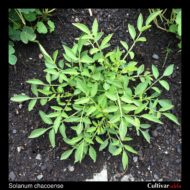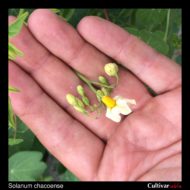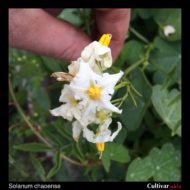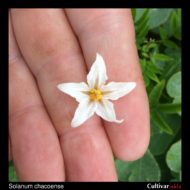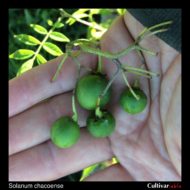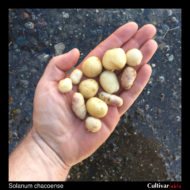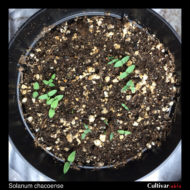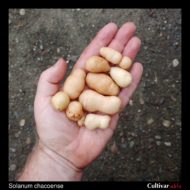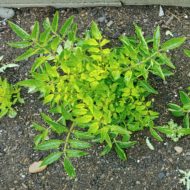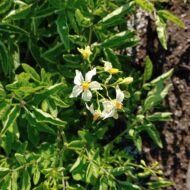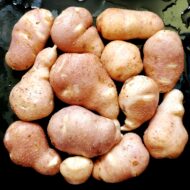Solanum chacoense
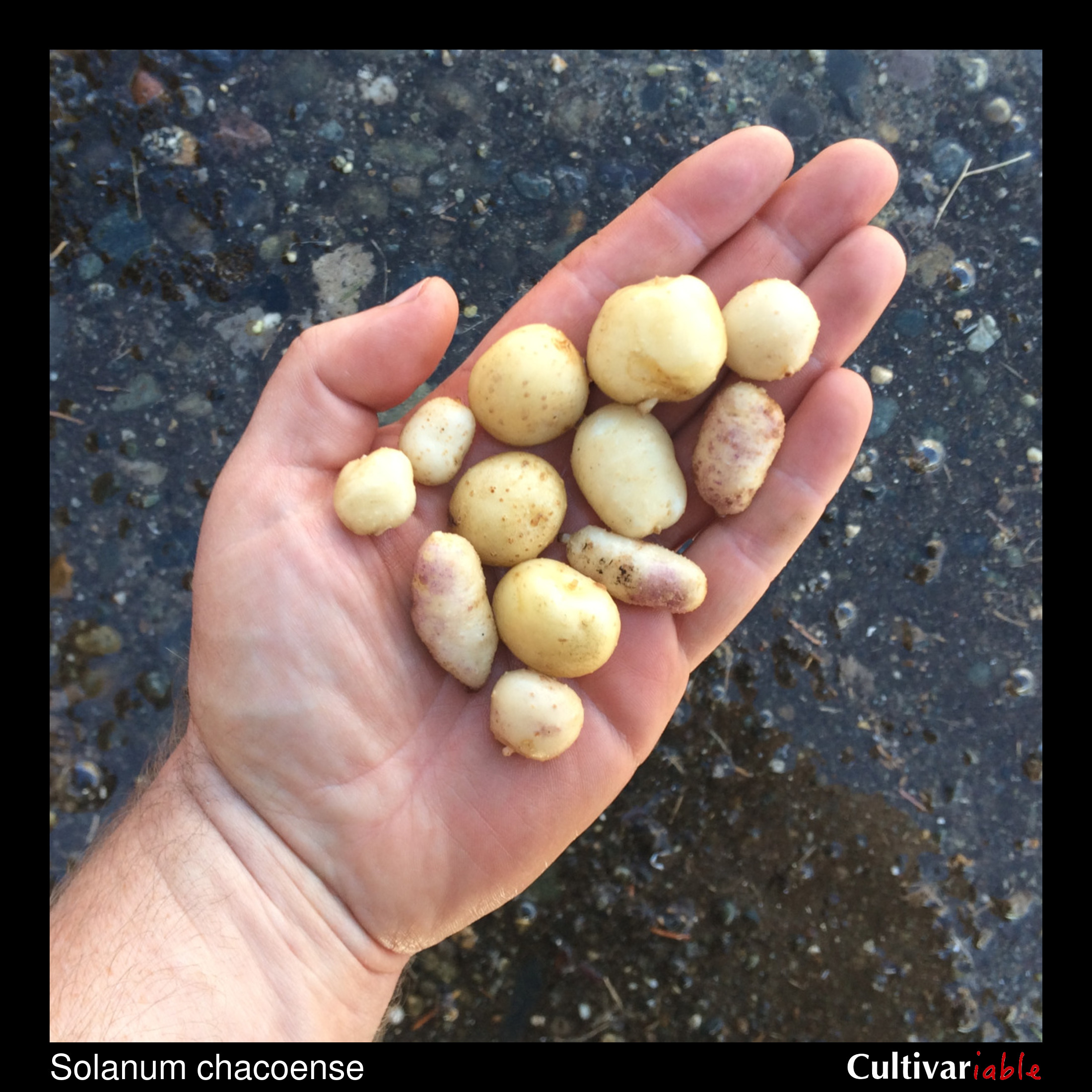
| Common Names | Ahuara papa, Papa ra, Para papa, Papa de zorro |
| Code | chc |
| Synonyms | S. arnezii, S. bitteri, S. boergeri, S. caipipendense, S. calvescens, S. cuevoanum, S. emmeae, S. garciae, S. gibberulosum, S. guaraniticum, S. horovitzii, S. jujuyense, S. knappei, S. laplaticum, S. limense, S. muelleri, S. paraguariense, S. parodii, S. pseudo-maglia, S. renggeri, S. saltense, S. schickii, S. subtilius, S. yungasense |
| Clade | 4 |
| Series | Yungasense |
| Ploidy | Diploid (2x), Triploid (3x) |
| EBN | 2 |
| Tuberization Photoperiod | Mixed |
| Self-compatibility | No |
| Nuclear Genome | A |
| Cytoplasmic Genome | W |
| Citation | Bitter: Repert. Spec. Nov. Regni Veg. 11: 18. 1912. |
Description
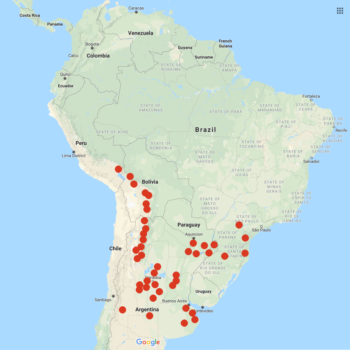
Solanum chacoense is a very diverse and widely spread species, ranging from Peru south and east into Bolivia, Argentina, Paraguay, Uruguay, and Brazil, where it grows from sea level up to about 6500 feet (2000 m). Plants are typically between 1 and 2 feet tall, with narrow strongly pointed leaves. It grows in a wide variety of habitats and is common weed of cultivated ground as well. Flowers are white. Berries are ovate to conical, green, sometimes with white spots. Tubers are typically small, mostly less than an inch, occasionally reaching as much as three inches. They are usually white to tan in color, less commonly blue, usually with prominent lenticels.
The specific epithet, chacoense, presumably refers to Chaco Province, Argentina. While there is no completely standardized pronunciation for scientific names, the most common way to pronounce this species is probably so-LAY-num cha-koh-EN-see. If disregarding the original pronunciation of names or native words, you might instead use the pronunciation kah-koh-EN-see.
Habitat includes riverbanks and fallow fields, sometimes as a weed in cornfields at elevations around 4000 feet (1200 m) (Hawkes 1969).
Although most South American wild potato species are short day tuberizers, some accessions of S. chacoense are able to tuberize under long days.
Subramanian (2017) found that at least some accessions of this species have unusually low calcium and potassium content and unusually high dry matter.
Resistances
Bethke (2017) scored wild potato species as a composite of seven resistance studies and S. chacoense ranked in third place.
Some accessions of S. chacoense deter the feeding of Colorado potato beetle and many other insects due to leptines (acylated glycoalkaloids) in the foliage. Leptines are not common in S. chacoense and so far have not been found at all in other potato species (Sinden 1986). Leptines were not found to accumulate in the tubers even when allowed to green (Sinden 1986b). Sinden (1980) found the least damage from Colorado potato beetle in varieties that had forms of commersonine as their primary glycoalkaloids.
This species can survive frosts down to 26 degrees F (-3.5 C) (Li 1977). Vega (1995) found that this species is about as frost tolerant as domesticated potato.
Some accessions of this species carry the Rpi-chc1 gene, conferring late blight resistance.
| Condition | Type | Level of Resistance | Source |
|---|---|---|---|
| Alternaria solani (Early Blight) | Fungus | Somewhat resistant | Jansky 2008 |
| Clavibacter michiganensis (Ring Rot) | Bacterium | Somewhat resistant | Ross 1958 |
| Drought | Abiotic | Somewhat resistant | Machida-Hirano 2015 |
| Empoasca fabae (Potato Leafhopper) | Invertebrate | Somewhat resistant | Sleesman 1940 |
| Frost | Abiotic | Somewhat resistant | Machida-Hirano 2015 |
| Globodera rostochiensis (Potato Cyst/Golden Nematode) | Invertebrate | Somewhat resistant | Castelli 2003 |
| Globodera pallida (Pale Cyst Nematode) | Invertebrate | Somewhat resistant | Castelli 2003 |
| Globodera pallida (Pale Cyst Nematode) | Invertebrate | Not resistant | Bachmann-Pfabe 2019 |
| Heat | Abiotic | Somewhat resistant | Machida-Hirano 2015 |
| Leptinotarsa decemlineata (Colorado Potato Beetle) | Invertebrate | Somewhat resistant | Stelzner 1943, Schaper 1953, Torka 1943, Machida-Hirano 2015 |
| Liriomyza huidobrensis (Potato Leaf Miner) | Invertebrate | Somewhat resistant | Ochoa 1990 |
| Meloidogyne spp. (Root Knot Nematode) | Invertebrate | Somewhat resistant | Machida-Hirano 2015 |
| Myzus persicae (Green Peach Aphid) | Invertebrate | Somewhat resistant | Adams 1946 |
| Phytophthora infestans (Late Blight) | Fungus | Not resistant | Gonzales 2002 |
| Phytophthora infestans (Late Blight) | Fungus | Somewhat resistant | Machida-Hirano 2015, Bachmann-Pfabe 2019 |
| Ralstonia solanacearum (Bacterial Wilt) | Bacterium | Somewhat resistant | Machida-Hirano 2015 |
| Pectobacterium carotovorum (Blackleg/Soft Rot) | Bacterium | Somewhat resistant | Chung 2011, Machida-Hirano 2015 |
| Metaphorical operculella (Potato Tuber Moth) | Invertebrate | Somewhat resistant | Ochoa 1990 |
| Potato Leafroll Virus (PLRV) | Virus | Somewhat resistant | Ross 1950, Ross 1958, Ochoa 1990 |
| Potato Virus A (PVA) | Virus | Resistant | Wetter 1971 |
| Potato Virus X (PVX) | Virus | Somewhat resistant | Lebedeva 1978, Machida-Hirano 2015 |
| Potato Virus Y (PVY) | Virus | Somewhat resistant, Resistant | Ross 1950, Ross 1958, Ochoa 1990, Cai 2011, Machida-Hirano 2015, Wetter 1971 |
| Potato Virus Y (PVY), C Strain | Virus | Resistant | Takacs 1999 (as S. arnezii) |
| Streptomyces scabiei (Scab) | Bacterium | Somewhat resistant | Machida-Hirano 2015 |
| Streptomyces scabiei (Scab) | Bacterium | Immune | Reddick 1939 |
| Synchytrium endobioticum (Wart) | Fungus | Somewhat resistant | Machida-Hirano 2015, Ross 1958 |
| Verticillium spp. (Verticillium Wilt) | Fungus | Somewhat resistant | Lynch 1997 |
Glykoalkaloid content
The glycoalkaloid composition of S. chacoense varies considerably between accessions. Sinden (1980), found six different glycoalkaloid profiles for this species: commersonine; solanine; dihydrocommersonine; leptines and commersonine; solanine and chaconine; dihydrosolanine and dihydrochaconine; and leptines with dihydrosolanine and dihydrochaconine. Sinden (1986b) found TGA levels ranging from 134 to 279 mg / 100 g across three clones of S. chacoense.
Images
Cultivation
Bamberg (2017) found a 306% increase in seed set in this species with supplemental applications of liquid fertilizer at four and seven weeks after potting.
Towill (1983) found that seeds of this species stored at 1 to 3 degrees C germinated at 90% after 25 years.
I recommend isolating S. chacoense from domesticated diploids by at least 40 feet if you will be saving seed. This species appears to be a very effective pollinator and progeny of crosses with diploid S. tuberosum are mostly bitter.
S. chacoense has shown a significant ability to naturalize and become weedy in foreign environments (Simon 2010). Care should be taken to prevent this species from escaping and growing unmanageably, a precaution that should be taken with all wild potato species until you have experience with them. There is a lot of rainfall in most of its native range, but it appears to tolerate drought very well.
Trapero-Mozos (2018) determined that this species will tolerate a temperature of 40 C even without prior acclimatization to warm temperatures.
Breeding
Lynch (1997) identified a dominant, single gene source of Verticillium resistance in some accessions of S. chacoense. This could likely be crossed into S. tuberosum without too much difficulty.
Ochoa (1990) reported that the pollen fertility of triploid S. chacoense (as S. yungasense) was 45-50%, a surprisingly high value for a triploid.
Crosses with S. tuberosum
S. chacoense has been used extensively in potato breeding. Varieties that include S. chacoense in their pedigrees include Allagash Russet, Atlantic, Belchip, Campbell 11 and 14, Chipbelle, Conestoga, Denali, Islander, Lenape, Norking Russet, Russette, Seminole, Simcoe, Sunrise, Trent, Yankee Chipper, Yankee Supreme (Plaisted 1989), Andover, Chipeta, Mainestay, NorValley, Pike, and Snowden (Love 1999).
| Female | Male | Berry Set |
Seed Set | Germ | Ploidy | Source |
|---|---|---|---|---|---|---|
| S. chacoense | S. tuberosum 2x | Yes | Yes | Ochoa (1990) | ||
| S. chacoense | S. tuberosum 4x | None | None | Jackson (1999) | ||
| S. tuberosum 2x | S. chacoense | Yes | Yes | Ochoa (1990) | ||
| S. tuberosum 4x | S. chacoense | Low | Low | Jackson (1999) |
Crosses with other species
Jackson (1999) found 2-11% 2n pollen for this species.
| Female | Male | Berry Set |
Seed Set | Germ | Ploidy | Source |
|---|---|---|---|---|---|---|
| S. chacoense | S. berthaultii | High | High | Ochoa (1990) | ||
| S. chacoense | S. brevicaule (as S. vidaurrei) | Yes | Yes | Ochoa (1990) | ||
| S. commersonii |
S. chacoense |
Yes | Yes | Yes | 2x | Propach 1940 |
| S. commersonii |
S. chacoense |
No | Hawkes 1969 |
Cultivars
M6
M6 is an improved variety of S. chacoense, introduced in 2014. It was produced by seven generations of self pollination beginning with an S. chacoense accession bearing the Sli gene. It is homozygous for the Sli gene, able to self-pollinate and produce vigorous progeny, and is a day neutral tuberizer. M6 can be used in breeding with domesticated diploids to reliably introduce self-compatibility, since the Sli gene is dominant. M6 may not be pure S. chacoense, likely having hybridized at some point in its ancestry (Clot 2020).
References
Solanum chacoense at Solanaceae Source

